View in other NatureServe Network Field Guides
NatureServe
Montana
Utah
Wyoming
Idaho
Wisconsin
British Columbia
South Carolina
Yukon
California
New York
Rough-legged Hawk - Buteo lagopus
Native Species
Global Rank:
G5
State Rank:
S5N
(see State Rank Reason below)
Agency Status
USFWS:
MBTA
USFS:
BLM:
PIF:
External Links
State Rank Reason (see State Rank above)
Species is a common winter resident through Montana. Trend is likely stable and it faces no known threats.
General Description
Both sexes have dark brown back and wings, light mottled-brown head, and a white tail with a black terminal band. Most birds have a wide, dark brown belly band. In flight, the wing undersides are white with brown tips. Light-phase birds have a dark patch of brown midway along the forward edge of the wing. Dark-phase birds are dark chocolate-brown all over, except for white wing feathers on the undersides, and the mostly white tail. The sexes can be told apart by the tail: Males have dark barring above the terminal band, while females have a single solid terminal band, with no barring. Rough-legged Hawks range in length from 19 to 24 inches, and have a wingspan of 48 to 56 inches.
For a comprehensive review of the conservation status, habitat use, and ecology of this and other Montana bird species, please see
Marks et al. 2016, Birds of Montana.Diagnostic Characteristics
Other Montana buteo hawks lack the white tail with dark terminal band. The time of year is the best clue, since Rough-legged Hawks are the most common hawk seen during the winter, but are absent from Montana during the summer when other hawks are most common. Immature Golden Eagles are larger and have dark flight feathers.
Species Range
Montana Range
Range Descriptions
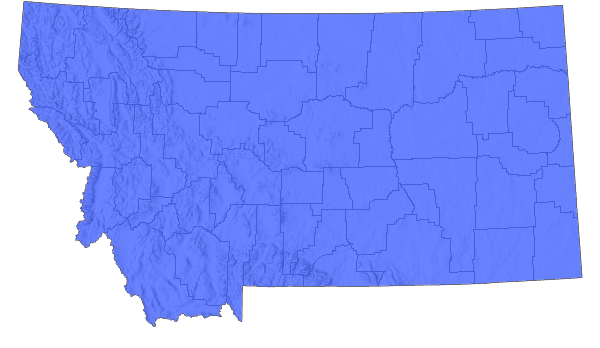 Western Hemisphere Range
Western Hemisphere Range
 eBird Occurrence Map
eBird Occurrence Map
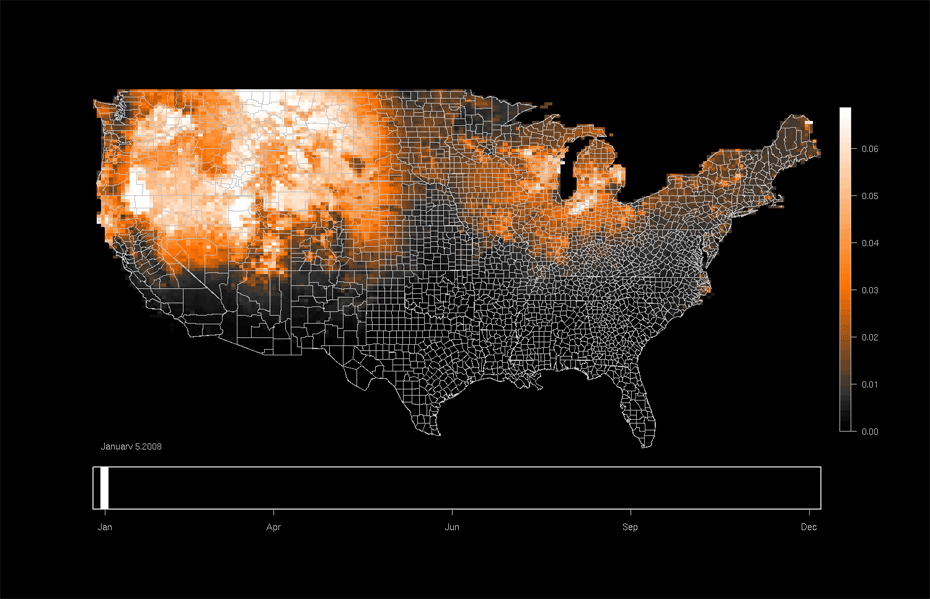
Click the map for more info.
Courtesy of

and

Observations in Montana Natural Heritage Program Database
Number of Observations: 19704
(Click on the following maps and charts to see full sized version)
Map Help and Descriptions
Relative Density
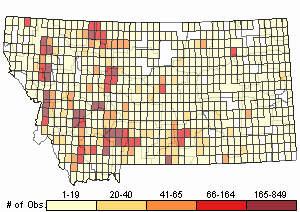
Recency
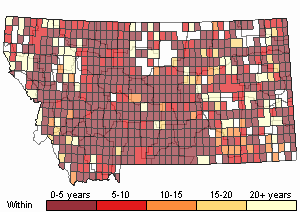
SUMMER (Feb 16 - Dec 14)
Direct Evidence of Breeding

Indirect Evidence of Breeding

No Evidence of Breeding

WINTER (Dec 15 - Feb 15)
Regularly Observed

Not Regularly Observed

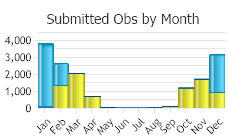
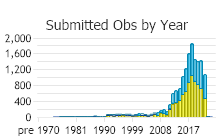
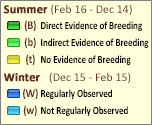 (Observations spanning multiple months or years are excluded from time charts)
(Observations spanning multiple months or years are excluded from time charts)
Migration
Rough-legged Hawks nest in northern Canada and Alaska, and migrate to the lower 48 states in winter. They are most numerous in Montana from October through March. In winter, Rough-legged Hawks are the most common buteo hawk. Bozeman area migration: November 5 to December 10 and March 20 to April 8 (Skaar 1969).
Habitat
Rough-legged Hawks hunt over grasslands and agricultural land. They are often seen perched on utility poles and fence posts. Found in open areas of the Gallatin Valley (Skaar 1969).
Ecological Systems Associated with this Species
- Details on Creation and Suggested Uses and Limitations
How Associations Were Made
We associated the use and habitat quality (common or occasional) of each of the 82 ecological systems mapped in Montana for
vertebrate animal species that regularly breed, overwinter, or migrate through the state by:
- Using personal observations and reviewing literature that summarize the breeding, overwintering, or migratory habitat requirements of each species (Dobkin 1992, Hart et al. 1998, Hutto and Young 1999, Maxell 2000, Foresman 2012, Adams 2003, and Werner et al. 2004);
- Evaluating structural characteristics and distribution of each ecological system relative to the species' range and habitat requirements;
- Examining the observation records for each species in the state-wide point observation database associated with each ecological system;
- Calculating the percentage of observations associated with each ecological system relative to the percent of Montana covered by each ecological system to get a measure of "observations versus availability of habitat".
Species that breed in Montana were only evaluated for breeding habitat use, species that only overwinter in Montana were only evaluated for overwintering habitat use, and species that only migrate through Montana were only evaluated for migratory habitat use.
In general, species were listed as associated with an ecological system if structural characteristics of used habitat documented in the literature were present in the ecological system or large numbers of point observations were associated with the ecological system.
However, species were not listed as associated with an ecological system if there was no support in the literature for use of structural characteristics in an ecological system,
even if point observations were associated with that system.
Common versus occasional association with an ecological system was assigned based on the degree to which the structural characteristics of an ecological system matched the preferred structural habitat characteristics for each species as represented in scientific literature.
The percentage of observations associated with each ecological system relative to the percent of Montana covered by each ecological system was also used to guide assignment of common versus occasional association.
If you have any questions or comments on species associations with ecological systems, please contact the Montana Natural Heritage Program's Senior Zoologist.
Suggested Uses and Limitations
Species associations with ecological systems should be used to generate potential lists of species that may occupy broader landscapes for the purposes of landscape-level planning.
These potential lists of species should not be used in place of documented occurrences of species (this information can be requested at:
mtnhp.mt.gov/requests) or systematic surveys for species and evaluations of habitat at a local site level by trained biologists.
Users of this information should be aware that the land cover data used to generate species associations is based on imagery from the late 1990s and early 2000s and was only intended to be used at broader landscape scales.
Land cover mapping accuracy is particularly problematic when the systems occur as small patches or where the land cover types have been altered over the past decade.
Thus, particular caution should be used when using the associations in assessments of smaller areas (e.g., evaluations of public land survey sections).
Finally, although a species may be associated with a particular ecological system within its known geographic range, portions of that ecological system may occur outside of the species' known geographic range.
Literature Cited
- Adams, R.A. 2003. Bats of the Rocky Mountain West; natural history, ecology, and conservation. Boulder, CO: University Press of Colorado. 289 p.
- Dobkin, D. S. 1992. Neotropical migrant land birds in the Northern Rockies and Great Plains. USDA Forest Service, Northern Region. Publication No. R1-93-34. Missoula, MT.
- Foresman, K.R. 2012. Mammals of Montana. Second edition. Mountain Press Publishing, Missoula, Montana. 429 pp.
- Hart, M.M., W.A. Williams, P.C. Thornton, K.P. McLaughlin, C.M. Tobalske, B.A. Maxell, D.P. Hendricks, C.R. Peterson, and R.L. Redmond. 1998. Montana atlas of terrestrial vertebrates. Montana Cooperative Wildlife Research Unit, University of Montana, Missoula, MT. 1302 p.
- Hutto, R.L. and J.S. Young. 1999. Habitat relationships of landbirds in the Northern Region, USDA Forest Service, Rocky Mountain Research Station RMRS-GTR-32. 72 p.
- Maxell, B.A. 2000. Management of Montana's amphibians: a review of factors that may present a risk to population viability and accounts on the identification, distribution, taxonomy, habitat use, natural history, and the status and conservation of individual species. Report to U.S. Forest Service Region 1. Missoula, MT: Wildlife Biology Program, University of Montana. 161 p.
- Werner, J.K., B.A. Maxell, P. Hendricks, and D. Flath. 2004. Amphibians and reptiles of Montana. Missoula, MT: Mountain Press Publishing Company. 262 p.
- Commonly Associated with these Ecological Systems
Alpine Systems
Forest and Woodland Systems
Grassland Systems
Human Land Use
Recently Disturbed or Modified
Shrubland, Steppe and Savanna Systems
Sparse and Barren Systems
Wetland and Riparian Systems
- Occasionally Associated with these Ecological Systems
Forest and Woodland Systems
Recently Disturbed or Modified
Food Habits
They primarily prey upon small mammals such as ground squirrels, rabbits, and mice. They occasionally eat birds and insects.
Ecology
Light phase birds are most frequent in Bozeman area, but dark birds are regularly seen (Skaar 1969).
Stewardship Responsibility
References
- Literature Cited AboveLegend:
 View Online Publication
View Online Publication Marks, J.S., P. Hendricks, and D. Casey. 2016. Birds of Montana. Arrington, VA. Buteo Books. 659 pages.
Marks, J.S., P. Hendricks, and D. Casey. 2016. Birds of Montana. Arrington, VA. Buteo Books. 659 pages. Skaar, P.D. 1969. Birds of the Bozeman latilong: a compilation of data concerning the birds which occur between 45 and 46 N. latitude and 111 and 112 W. longitude, with current lists for Idaho, Montana, Wyoming, impinging Montana counties and Yellowstone National Park. Bozeman, MT. 132 p.
Skaar, P.D. 1969. Birds of the Bozeman latilong: a compilation of data concerning the birds which occur between 45 and 46 N. latitude and 111 and 112 W. longitude, with current lists for Idaho, Montana, Wyoming, impinging Montana counties and Yellowstone National Park. Bozeman, MT. 132 p.
- Additional ReferencesLegend:
 View Online Publication
View Online Publication
Do you know of a citation we're missing? American Ornithologists’ Union [AOU]. 1998. Check-list of North American birds, 7th edition. American Ornithologists’ Union, Washington, D.C. 829 p.
American Ornithologists’ Union [AOU]. 1998. Check-list of North American birds, 7th edition. American Ornithologists’ Union, Washington, D.C. 829 p. Anderson, D.E., O.J. Rongstad, and W.R. Mytton. 1985. Line transect analysis of raptor abundance along roads. Wildl. Soc. Bull. 13(4):533-539.
Anderson, D.E., O.J. Rongstad, and W.R. Mytton. 1985. Line transect analysis of raptor abundance along roads. Wildl. Soc. Bull. 13(4):533-539. Bechard, M. J., and T. R. Swem. 2002. Rough-legged Hawk (Buteo lagopus). In The birds of North America, No. 641 (A. Poole and F. Gill, Eds.). Academy of Natural Sciences of Philadelphia and American Ornithologists’ Union.
Bechard, M. J., and T. R. Swem. 2002. Rough-legged Hawk (Buteo lagopus). In The birds of North America, No. 641 (A. Poole and F. Gill, Eds.). Academy of Natural Sciences of Philadelphia and American Ornithologists’ Union. Becker, Dale M., 1980, A Survey of raptors on national forest land in Carter County, Montana. Final Progress Report: 1977-1979.
Becker, Dale M., 1980, A Survey of raptors on national forest land in Carter County, Montana. Final Progress Report: 1977-1979. Bird Conservancy of the Rockies. 2017. Pocket Guide to Northern Prairie Birds. Brighton, CO: Bird Conservancy of the Rockies. 98 p.
Bird Conservancy of the Rockies. 2017. Pocket Guide to Northern Prairie Birds. Brighton, CO: Bird Conservancy of the Rockies. 98 p. Cameron, E. S. 1907. The birds of Custer and Dawson counties, Montana. Auk 24(3): 241-270.
Cameron, E. S. 1907. The birds of Custer and Dawson counties, Montana. Auk 24(3): 241-270. Confluence Consulting Inc. 2011. Montana Department of Transportation Wetland Mitigation Monitoring Reports (various sites). MDT Helena, MT.
Confluence Consulting Inc. 2011. Montana Department of Transportation Wetland Mitigation Monitoring Reports (various sites). MDT Helena, MT. Dickson, D.C. 1991. Systematic wildlife observations on the Blackfoot-Clearwater Wildlife Management Area. Montana Department of Fish, Wildlife and Parks. Missoula, MT. 14 pp. plus appendices and photographs.
Dickson, D.C. 1991. Systematic wildlife observations on the Blackfoot-Clearwater Wildlife Management Area. Montana Department of Fish, Wildlife and Parks. Missoula, MT. 14 pp. plus appendices and photographs. Dood, A.R. 1980. Terry Badlands nongame survey and inventory final report. Montana Department of Fish, Wildlife, and Parks and Bureau of Land Management, Helena, MT. 70 pp.
Dood, A.R. 1980. Terry Badlands nongame survey and inventory final report. Montana Department of Fish, Wildlife, and Parks and Bureau of Land Management, Helena, MT. 70 pp. DuBois, K. and D. Becker. 1987. Identification of Montana's birds of prey. Montana Outdoors Nov/Dec. 20 p.
DuBois, K. and D. Becker. 1987. Identification of Montana's birds of prey. Montana Outdoors Nov/Dec. 20 p. ECON, Inc. (Ecological Consulting Service), Helena, MT., 1975, Colstrip 10 x 20 Area wildlife and wildlife habitat annual monitoring report, 1975. Proj. 71-23-A. December 31, 1975.
ECON, Inc. (Ecological Consulting Service), Helena, MT., 1975, Colstrip 10 x 20 Area wildlife and wildlife habitat annual monitoring report, 1975. Proj. 71-23-A. December 31, 1975. ECON, Inc. (Ecological Consulting Service), Helena, MT., 1976, Colstrip 10 x 20 Area wildlife and wildlife habitat annual monitoring report, 1976. Proj. 135-85-A. December 31, 1976.
ECON, Inc. (Ecological Consulting Service), Helena, MT., 1976, Colstrip 10 x 20 Area wildlife and wildlife habitat annual monitoring report, 1976. Proj. 135-85-A. December 31, 1976. Econ, Inc. (Ecological Consulting Service), Helena, MT., 1977, 1977 wildlife and wildlife habitat monitoring study, Peabody Coal Company Big Sky Mine. Proj. 161-85-A. November 30, 1977.
Econ, Inc. (Ecological Consulting Service), Helena, MT., 1977, 1977 wildlife and wildlife habitat monitoring study, Peabody Coal Company Big Sky Mine. Proj. 161-85-A. November 30, 1977. ECON, Inc. (Ecological Consulting Service), Helena, MT., 1977, Colstrip 10 x 20 Area wildlife and wildlife habitat annual monitoring report, 1977. Proj. 164-85-A. December 31, 1977.
ECON, Inc. (Ecological Consulting Service), Helena, MT., 1977, Colstrip 10 x 20 Area wildlife and wildlife habitat annual monitoring report, 1977. Proj. 164-85-A. December 31, 1977. ECON, Inc. (Ecological Consulting Service), Helena, MT., 1979, Annual wildllife report of the Colstrip Area for 1978. Proj. 195-85-A. April 6, 1979.
ECON, Inc. (Ecological Consulting Service), Helena, MT., 1979, Annual wildllife report of the Colstrip Area for 1978. Proj. 195-85-A. April 6, 1979. ECON, Inc. (Ecological Consulting Service), Helena, MT., 1979, Annual wildllife report of the Colstrip Area for 1979, including a special raptor research study. Proj. 216-85-A. March 1, 1980.
ECON, Inc. (Ecological Consulting Service), Helena, MT., 1979, Annual wildllife report of the Colstrip Area for 1979, including a special raptor research study. Proj. 216-85-A. March 1, 1980. ECON, Inc. (Ecological Consulting Service), Helena, MT., 1979, Area B four-section wildlife report. August 3, 1979.
ECON, Inc. (Ecological Consulting Service), Helena, MT., 1979, Area B four-section wildlife report. August 3, 1979. Econ, Inc. 1988. Wildlife monitoring report, 1987 field season, Big Sky Mine. March 1988. In Peabody Mining and Reclamation Plan Big Sky Mine Area B. Vol. 8, cont., Tab 10 - Wildlife Resources. Appendix 10-1, 1987 Annual Wildlife Report.
Econ, Inc. 1988. Wildlife monitoring report, 1987 field season, Big Sky Mine. March 1988. In Peabody Mining and Reclamation Plan Big Sky Mine Area B. Vol. 8, cont., Tab 10 - Wildlife Resources. Appendix 10-1, 1987 Annual Wildlife Report. Econ, Inc., Helena, MT., 1978, Peabody Coal Company Big Sky Mine, Rosebud County, MT. Wildlife and wildlife habitat monitoring study. Proj. 190-85-A. December 31, 1978.
Econ, Inc., Helena, MT., 1978, Peabody Coal Company Big Sky Mine, Rosebud County, MT. Wildlife and wildlife habitat monitoring study. Proj. 190-85-A. December 31, 1978. Ehrlich, P., D. Dobkin, and D. Wheye. 1988. The birder’s handbook: a field guide to the natural history of North American birds. Simon and Schuster Inc. New York. 785 pp.
Ehrlich, P., D. Dobkin, and D. Wheye. 1988. The birder’s handbook: a field guide to the natural history of North American birds. Simon and Schuster Inc. New York. 785 pp. Farmer, Patrick J., and Thomas W. Butts, Western Technology & Eng., Inc., Helena, MT., 1994, McDonald Project Terrestrial Wildlife Study, November 1989 - November 1993. April 1994. In McDonald Gold Project: Wildlife & Fisheries. [#18]. Seven-up Pete Joint Venture, Lincoln, MT. Unpub. No date.
Farmer, Patrick J., and Thomas W. Butts, Western Technology & Eng., Inc., Helena, MT., 1994, McDonald Project Terrestrial Wildlife Study, November 1989 - November 1993. April 1994. In McDonald Gold Project: Wildlife & Fisheries. [#18]. Seven-up Pete Joint Venture, Lincoln, MT. Unpub. No date. Fjell, Alan K., 1986, Peabody Coal Company Big Sky Mine, Rosebud County, MT. Wildlife monitoring report: 1985 field season. March 1986.
Fjell, Alan K., 1986, Peabody Coal Company Big Sky Mine, Rosebud County, MT. Wildlife monitoring report: 1985 field season. March 1986. Fjell, Alan K., and Brian R. Mahan, compilers., 1984, Peabody Coal Company Big Sky Mine, Rosebud County, MT. Wildlife monitoring report: 1983 field season. February 1984.
Fjell, Alan K., and Brian R. Mahan, compilers., 1984, Peabody Coal Company Big Sky Mine, Rosebud County, MT. Wildlife monitoring report: 1983 field season. February 1984. Fjell, Alan K., and Brian R. Mahan., 1985, Peabody Coal Company Big Sky Mine, Rosebud County, MT. Wildlife monitoring report: 1984 field season. February 1985.
Fjell, Alan K., and Brian R. Mahan., 1985, Peabody Coal Company Big Sky Mine, Rosebud County, MT. Wildlife monitoring report: 1984 field season. February 1985. Fjell, Alan K., and Brian R. Mahan., 1987, Big Sky Mine, Rosebud County, MT. Wildlife monitoring report: 1986 field season. April 1987.
Fjell, Alan K., and Brian R. Mahan., 1987, Big Sky Mine, Rosebud County, MT. Wildlife monitoring report: 1986 field season. April 1987. Flathead National Forest. 1994. Wildlife landscape evaluation: Swan Valley. USDA Forest Service, Kalispell, Mont.
Flathead National Forest. 1994. Wildlife landscape evaluation: Swan Valley. USDA Forest Service, Kalispell, Mont. Gillihan, SW. and T. VerCauteren. 2015. Pocket Guide to Prairie Birds. Brighton, CO: Bird Conservancy of the Rockies. 91 p.
Gillihan, SW. and T. VerCauteren. 2015. Pocket Guide to Prairie Birds. Brighton, CO: Bird Conservancy of the Rockies. 91 p. Gniadek, S. 1983. Southwest Glendive Wildlife Baseline Inventory. Miles City, Mont: Bureau of Land Management, Miles City District Office. 56 pp with appendices.
Gniadek, S. 1983. Southwest Glendive Wildlife Baseline Inventory. Miles City, Mont: Bureau of Land Management, Miles City District Office. 56 pp with appendices. Haight, C.P. 1937. Some observations on the predator-prey complex in the Gallatin Valley. M.Sc. Thesis. Bozeman, Montana: Montana State University. 58 p.
Haight, C.P. 1937. Some observations on the predator-prey complex in the Gallatin Valley. M.Sc. Thesis. Bozeman, Montana: Montana State University. 58 p. Hays, R., R.L. Eng, and C.V. Davis (preparers). 1984. A list of Montana birds. Helena, MT: MT Dept. of Fish, Wildlife & Parks.
Hays, R., R.L. Eng, and C.V. Davis (preparers). 1984. A list of Montana birds. Helena, MT: MT Dept. of Fish, Wildlife & Parks. Johnsgard, P.A. 1990. Hawks, eagles, and falcons of North America. Smithsonian Institution Press, Washington, D.C. 403 pp.
Johnsgard, P.A. 1990. Hawks, eagles, and falcons of North America. Smithsonian Institution Press, Washington, D.C. 403 pp. Johnsgard, P.A. 1992. Birds of the Rocky Mountains with particular reference to national parks in the northern Rocky Mountain region. Lincoln: University of Nebraska Press. xi + 504 pp.
Johnsgard, P.A. 1992. Birds of the Rocky Mountains with particular reference to national parks in the northern Rocky Mountain region. Lincoln: University of Nebraska Press. xi + 504 pp. Joslin, Gayle, and Heidi B. Youmans. 1999. Effects of recreation on Rocky Mountain wildlife: a review for Montana. [Montana]: Montana Chapter of the Wildlife Society.
Joslin, Gayle, and Heidi B. Youmans. 1999. Effects of recreation on Rocky Mountain wildlife: a review for Montana. [Montana]: Montana Chapter of the Wildlife Society. Lenard, S., J. Carlson, J. Ellis, C. Jones, and C. Tilly. 2003. P. D. Skaar's Montana bird distribution, 6th edition. Montana Audubon, Helena, MT. 144 pp.
Lenard, S., J. Carlson, J. Ellis, C. Jones, and C. Tilly. 2003. P. D. Skaar's Montana bird distribution, 6th edition. Montana Audubon, Helena, MT. 144 pp. Lockhart, J. Michael, 1976, Effects of coal extraction and related development on wildlife populations. Annual progress report; Calendar year 1976. In Decker Coal Company West Pit Permit. Vol. 3. 26.4.304(10-11), 305, 306, and 307. Updated Rules Rewrite, July 1, 1991. Appendix F.
Lockhart, J. Michael, 1976, Effects of coal extraction and related development on wildlife populations. Annual progress report; Calendar year 1976. In Decker Coal Company West Pit Permit. Vol. 3. 26.4.304(10-11), 305, 306, and 307. Updated Rules Rewrite, July 1, 1991. Appendix F. Matthews, W.L. 1981. Broadus-Pumpkin Creek baseline inventory - wildlife. Bureau of Land Management, Miles City, MT. 83 p.
Matthews, W.L. 1981. Broadus-Pumpkin Creek baseline inventory - wildlife. Bureau of Land Management, Miles City, MT. 83 p. Maxim Technologies, Inc., 2002, Western Energy Company Rosebud Mine, Colstrip, Montana: 2002 Annual Wildlife Monitoring Report; December 1, 2001 - November 30, 2002. Febr. 24, 2002.
Maxim Technologies, Inc., 2002, Western Energy Company Rosebud Mine, Colstrip, Montana: 2002 Annual Wildlife Monitoring Report; December 1, 2001 - November 30, 2002. Febr. 24, 2002. Montana Bird Distribution Committee. 2012. P.D. Skaar's Montana bird distribution. 7th Edition. Montana Audubon, Helena, Montana. 208 pp. + foldout map.
Montana Bird Distribution Committee. 2012. P.D. Skaar's Montana bird distribution. 7th Edition. Montana Audubon, Helena, Montana. 208 pp. + foldout map. Montana Dept. of State Lands, 1976, Draft environmental impact statement for proposed open cut mining contract for Amercan Colloid Company. November 12, 1976.
Montana Dept. of State Lands, 1976, Draft environmental impact statement for proposed open cut mining contract for Amercan Colloid Company. November 12, 1976. MT Fish, Wildlife & Parks. No date. Blackfoot-Clearwater Wildlife Management Area checklist.
MT Fish, Wildlife & Parks. No date. Blackfoot-Clearwater Wildlife Management Area checklist. Oechsli, L.M. 2000. Ex-urban development in the Rocky Mountain West: consequences for native vegetation, wildlife diversity, and land-use planning in Big Sky, Montana. M.Sc. Thesis. Montana State University, Bozeman. 73 p.
Oechsli, L.M. 2000. Ex-urban development in the Rocky Mountain West: consequences for native vegetation, wildlife diversity, and land-use planning in Big Sky, Montana. M.Sc. Thesis. Montana State University, Bozeman. 73 p. Omland, K.S. and E.G. Meyer. 1992. Fall 1991 raptor migration study in the Bozeman, Montana vicinity. Prepared for the Gallatin National Forest, by HawkWatch International, Inc. 31 p.
Omland, K.S. and E.G. Meyer. 1992. Fall 1991 raptor migration study in the Bozeman, Montana vicinity. Prepared for the Gallatin National Forest, by HawkWatch International, Inc. 31 p. Rundquist, V.M. 1973. Avian ecology on stock ponds in two vegetational types in north-central Montana. Ph.D. Dissertation. Bozeman, MT: Montana State University. 112 p.
Rundquist, V.M. 1973. Avian ecology on stock ponds in two vegetational types in north-central Montana. Ph.D. Dissertation. Bozeman, MT: Montana State University. 112 p. Ryder, R.A. 1972. Avian population studies on the Pawnee site, 1968-1971. Fort Collins, CO: Colorado State University. Grassland Biome, U.S. International Biological Program, Tech. Rep. 57 p.
Ryder, R.A. 1972. Avian population studies on the Pawnee site, 1968-1971. Fort Collins, CO: Colorado State University. Grassland Biome, U.S. International Biological Program, Tech. Rep. 57 p. Salt, W.R. and J.R. Salt. 1976. The birds of Alberta. Hurtig Publishers, Edmonton, Alberta. xv + 498 pp.
Salt, W.R. and J.R. Salt. 1976. The birds of Alberta. Hurtig Publishers, Edmonton, Alberta. xv + 498 pp. Sater, S. 2022. The insects of Sevenmile Creek, a pictorial guide to their diversity and ecology. Undergraduate Thesis. Helena, MT: Carroll College. 242 p.
Sater, S. 2022. The insects of Sevenmile Creek, a pictorial guide to their diversity and ecology. Undergraduate Thesis. Helena, MT: Carroll College. 242 p. Saunders, A.A. 1914. The birds of Teton and northern Lewis & Clark counties, Montana. Condor 16:124-144.
Saunders, A.A. 1914. The birds of Teton and northern Lewis & Clark counties, Montana. Condor 16:124-144. Schnell, G.D. 1968. Differential habitat utilization by wintering rough-legged and red-tailed hawks. Condor 70:373-77.
Schnell, G.D. 1968. Differential habitat utilization by wintering rough-legged and red-tailed hawks. Condor 70:373-77. Sibley, D. 2014. The Sibley guide to birds. Alfred A. Knopf, New York, NY. 598 pp.
Sibley, D. 2014. The Sibley guide to birds. Alfred A. Knopf, New York, NY. 598 pp. Skaar, P. D., D. L. Flath, and L. S. Thompson. 1985. Montana bird distribution. Montana Academy of Sciences Monograph 3(44): ii-69.
Skaar, P. D., D. L. Flath, and L. S. Thompson. 1985. Montana bird distribution. Montana Academy of Sciences Monograph 3(44): ii-69. Smith, J. 2000. Recap of the fall 2000 migration season, Bridger Mountains. Raptor Watch 15(1):6-10.
Smith, J. 2000. Recap of the fall 2000 migration season, Bridger Mountains. Raptor Watch 15(1):6-10. Swan River National Wildlife Refuge. 1982. Birds of the Swan River NWR. Kalispell, MT: NW MT Fish and Wildlife Center pamphlet.
Swan River National Wildlife Refuge. 1982. Birds of the Swan River NWR. Kalispell, MT: NW MT Fish and Wildlife Center pamphlet. Thomas, J. W. (ed). 1979. Wildlife habitats in managed forests: the Blue Mountains of Oregon and Washington. Agriculture Handbook 553, USDA, Forest Service, Wildlife Management Institute, Washington, DC. 512 pp.
Thomas, J. W. (ed). 1979. Wildlife habitats in managed forests: the Blue Mountains of Oregon and Washington. Agriculture Handbook 553, USDA, Forest Service, Wildlife Management Institute, Washington, DC. 512 pp. Thompson, L.S. 1981. Circle West wildlife monitoring study: Third annual report. Technical report No. 8. Montana Department of Natural Resources and Conservation. Helena, Montana.
Thompson, L.S. 1981. Circle West wildlife monitoring study: Third annual report. Technical report No. 8. Montana Department of Natural Resources and Conservation. Helena, Montana. TVX Mineral Hill Mine, Amerikanuak, Inc., Gardiner, MT., 2002, Yearly summary of wildlife observation reports. 1990-2002 Letter reports.
TVX Mineral Hill Mine, Amerikanuak, Inc., Gardiner, MT., 2002, Yearly summary of wildlife observation reports. 1990-2002 Letter reports. U.S. Forest Service. 1991. Forest and rangeland birds of the United States: Natural history and habitat use. U.S. Department of Agriculture, Forest Service Agricultural Handbook 688. 625 pages.
U.S. Forest Service. 1991. Forest and rangeland birds of the United States: Natural history and habitat use. U.S. Department of Agriculture, Forest Service Agricultural Handbook 688. 625 pages. Urban, Larry, 2002, Biological Resources Report: Wagner Pit Wetland Restoration Site. Proj. No. STPX 56(50) CN 4645. February 23, 2002. In Wgner Pit WS#13 Upper Yellowstone, Yellowstone County. Fin. Dist. 5 AdminDist 5.
Urban, Larry, 2002, Biological Resources Report: Wagner Pit Wetland Restoration Site. Proj. No. STPX 56(50) CN 4645. February 23, 2002. In Wgner Pit WS#13 Upper Yellowstone, Yellowstone County. Fin. Dist. 5 AdminDist 5. Van Horn, R.C. 1993. Ferruginous Hawk and Prairie Falcon reproductive and behavioral responses to human activity near the Kevin Rim, Montana. M.Sc. Thesis. Bozeman, Montana: Montana State University. 86 p.
Van Horn, R.C. 1993. Ferruginous Hawk and Prairie Falcon reproductive and behavioral responses to human activity near the Kevin Rim, Montana. M.Sc. Thesis. Bozeman, Montana: Montana State University. 86 p. Waage, B.C. 1984. Western Energy Company Rosebud Mine, Rosebud County, Montana: Annual Wildlife Monitoring Report, 1983 Field Season. June 1984.
Waage, B.C. 1984. Western Energy Company Rosebud Mine, Rosebud County, Montana: Annual Wildlife Monitoring Report, 1983 Field Season. June 1984. Waage, B.C. 1986. Western Energy Company Rosebud Mine, Rosebud County, Montana: Annual Wildlife Monitoring Report, 1985 Field Season. December 1985.
Waage, B.C. 1986. Western Energy Company Rosebud Mine, Rosebud County, Montana: Annual Wildlife Monitoring Report, 1985 Field Season. December 1985. Waage, Bruce C., 1995, Western Energy Company Rosebud Mine, Colstrip, Montana:1994 Annual Wildlife Monitoring Report; December 1, 1993 - November 30, 1994. February 27, 1995.
Waage, Bruce C., 1995, Western Energy Company Rosebud Mine, Colstrip, Montana:1994 Annual Wildlife Monitoring Report; December 1, 1993 - November 30, 1994. February 27, 1995. Waage, Bruce C., 1996, Western Energy Company Rosebud Mine, Colstrip, Montana: 1995 Annual Wildlife Monitoring Report; December 1, 1994 - November 30, 1995. February 28, 1996.
Waage, Bruce C., 1996, Western Energy Company Rosebud Mine, Colstrip, Montana: 1995 Annual Wildlife Monitoring Report; December 1, 1994 - November 30, 1995. February 28, 1996. Waage, Bruce C., 1997, Western Energy Company Rosebud Mine, Colstrip, Montana: 1996 Annual Wildlife Monitoring Report; December 1, 1995 - November 30, 1996 Survey Period. February 28, 1997.
Waage, Bruce C., 1997, Western Energy Company Rosebud Mine, Colstrip, Montana: 1996 Annual Wildlife Monitoring Report; December 1, 1995 - November 30, 1996 Survey Period. February 28, 1997. Waage, Bruce C., 1998, Western Energy Company Rosebud Mine, Colstrip, Montana: 1997 Annual Wildlife Monitoring Report; December 1, 1996 - November 30, 1997 Survey Period. March 23, 1998.
Waage, Bruce C., 1998, Western Energy Company Rosebud Mine, Colstrip, Montana: 1997 Annual Wildlife Monitoring Report; December 1, 1996 - November 30, 1997 Survey Period. March 23, 1998. Waage, Bruce C., 1999, Western Energy Company Rosebud Mine, Colstrip, Montana: 1998 Annual Wildlife Monitoring Report; December 1, 1997 - November 30, 1998 Survey Period. February 24, 1999.
Waage, Bruce C., 1999, Western Energy Company Rosebud Mine, Colstrip, Montana: 1998 Annual Wildlife Monitoring Report; December 1, 1997 - November 30, 1998 Survey Period. February 24, 1999. Waage, Bruce C., 2001, Western Energy Company Rosebud Mine, Colstrip, Montana: 2000 Annual Wildlife Monitoring Report; December 1, 1999 - November 30, 2000. March 30, 2001.
Waage, Bruce C., 2001, Western Energy Company Rosebud Mine, Colstrip, Montana: 2000 Annual Wildlife Monitoring Report; December 1, 1999 - November 30, 2000. March 30, 2001. Waage, Bruce C., 2002, Western Energy Company Rosebud Mine, Colstrip, Montana. 2001 Annual Wildlife Monitoring Report; December 1, 2000 - November 30, 2001. Febr. 26, 2002.
Waage, Bruce C., 2002, Western Energy Company Rosebud Mine, Colstrip, Montana. 2001 Annual Wildlife Monitoring Report; December 1, 2000 - November 30, 2001. Febr. 26, 2002. Waage, Bruce C., compiler., 1985, Western Energy Company Rosebud Mine, Rosebud County, Montana: Annual Wildlife Monitoring Report, 1984 Field Season. October 1985.
Waage, Bruce C., compiler., 1985, Western Energy Company Rosebud Mine, Rosebud County, Montana: Annual Wildlife Monitoring Report, 1984 Field Season. October 1985. Waldt, R. 1995. The Pine Butte Swamp Preserve bird list. Choteau, MT: The Nature Conservancy. Updated August 1995.
Waldt, R. 1995. The Pine Butte Swamp Preserve bird list. Choteau, MT: The Nature Conservancy. Updated August 1995. Watts, C.R. and L.C. Eichhorn. 1981. Changes in the birds of central Montana. Proceedings of the Montana Academy of Sciences 40:31-40.
Watts, C.R. and L.C. Eichhorn. 1981. Changes in the birds of central Montana. Proceedings of the Montana Academy of Sciences 40:31-40. Western Energy Co., Colstrip, MT. Unpub., 1983, Western Energy Company's Application for Amendment to Surface Mining Permit NO. 8003, Area B: sections 7, 8, 17,18 T1N R41E, sections 12, 13 T1N R40E, Mining Expansion. March 1983.
Western Energy Co., Colstrip, MT. Unpub., 1983, Western Energy Company's Application for Amendment to Surface Mining Permit NO. 8003, Area B: sections 7, 8, 17,18 T1N R41E, sections 12, 13 T1N R40E, Mining Expansion. March 1983. Western Energy Co., Colstrip, MT., 1980, Western Energy Company Rosebud Mine, Colstrip, Montana: Annual Wildlife Report, 1980.
Western Energy Co., Colstrip, MT., 1980, Western Energy Company Rosebud Mine, Colstrip, Montana: Annual Wildlife Report, 1980. Western Energy Co., Colstrip, MT., 1981, Western Energy Company Rosebud Mine, Colstrip, Montana: Annual Wildlife Report, 1981.
Western Energy Co., Colstrip, MT., 1981, Western Energy Company Rosebud Mine, Colstrip, Montana: Annual Wildlife Report, 1981. Western Energy Co., Colstrip, MT., 1982, Western Energy Company Rosebud Mine, Colstrip, Montana: Annual Wildlife Report, 1982.
Western Energy Co., Colstrip, MT., 1982, Western Energy Company Rosebud Mine, Colstrip, Montana: Annual Wildlife Report, 1982. Western Technology & Engineering, Inc. (WESTECH)., 1991, 1991 Bull Mountains Mine No. 1 Terrestrial Wildlife Monitoring Study. In Meridian Minerals Company Bull Mountains Mine No. 1 Permit Application, Musselshell County, Montana. Vol. 7 of 14: Section 26
Western Technology & Engineering, Inc. (WESTECH)., 1991, 1991 Bull Mountains Mine No. 1 Terrestrial Wildlife Monitoring Study. In Meridian Minerals Company Bull Mountains Mine No. 1 Permit Application, Musselshell County, Montana. Vol. 7 of 14: Section 26 Western Technology and Engineering, Inc. (WESTECH). 1994. Wildlife Monitoring Absaloka Mine Area Annual Report, 1993. Montana SMP 85005. OSMP Montana 0007c. Mar. 12, 1994.
Western Technology and Engineering, Inc. (WESTECH). 1994. Wildlife Monitoring Absaloka Mine Area Annual Report, 1993. Montana SMP 85005. OSMP Montana 0007c. Mar. 12, 1994. Western Technology and Engineering, Inc. (WESTECH)., 1991, Wildlife Monitoring and Additional Baseline Inventory: Absaloka Mine Area Annual Report, 1991. Montana SMP 85005 R1. OSMP Montana 0007B. Febr. 25, 1991.
Western Technology and Engineering, Inc. (WESTECH)., 1991, Wildlife Monitoring and Additional Baseline Inventory: Absaloka Mine Area Annual Report, 1991. Montana SMP 85005 R1. OSMP Montana 0007B. Febr. 25, 1991. Western Technology and Engineering, Inc. (WESTECH)., 1993, Wildlife Monitoring Asaloka Mine Area Annual Report, 1992. Montana SMP 85005 R1. OSMP Montana 00078. 1993.
Western Technology and Engineering, Inc. (WESTECH)., 1993, Wildlife Monitoring Asaloka Mine Area Annual Report, 1992. Montana SMP 85005 R1. OSMP Montana 00078. 1993. Western Technology and Engineering, Inc. (WESTECH)., 1994, Wildlife Monitoring Absaloka Mine Area Annual Report, 1994. Montana SMP 85005. OSMP Montana 0007D. Febr. 24, 1994.
Western Technology and Engineering, Inc. (WESTECH)., 1994, Wildlife Monitoring Absaloka Mine Area Annual Report, 1994. Montana SMP 85005. OSMP Montana 0007D. Febr. 24, 1994. Westmoreland Resources, Inc., Hardin, MT., 1981, 1981 Wildlife Report. April 1982.
Westmoreland Resources, Inc., Hardin, MT., 1981, 1981 Wildlife Report. April 1982. Westmoreland Resources, Inc., Hardin, MT., 1983, 1980 Wildlife Monitoring Report. 12/21/79-12/20-80.
Westmoreland Resources, Inc., Hardin, MT., 1983, 1980 Wildlife Monitoring Report. 12/21/79-12/20-80. Westmoreland Resources, Inc., Hardin, MT., 1983, 1983 Wildlife Monitoring.
Westmoreland Resources, Inc., Hardin, MT., 1983, 1983 Wildlife Monitoring. Wittenhagen, K.W. 1991. Progress report on the ferruginous hawk in southeastern Montana. Miles City, MT: unpublished report for USDI BLM, Powder River and Big Dry Resource Areas. 24 p.
Wittenhagen, K.W. 1991. Progress report on the ferruginous hawk in southeastern Montana. Miles City, MT: unpublished report for USDI BLM, Powder River and Big Dry Resource Areas. 24 p. Zarn, M. 1974. Habitat management series for unique or endangered species. Report No.14, Rough-legged hawk (Buteo lagopus sanctijohannis). Denver, CO: U.S. Department of Interior, Bureau of Land Management, Technical Note, T-N-270. 23 p.
Zarn, M. 1974. Habitat management series for unique or endangered species. Report No.14, Rough-legged hawk (Buteo lagopus sanctijohannis). Denver, CO: U.S. Department of Interior, Bureau of Land Management, Technical Note, T-N-270. 23 p.
- Web Search Engines for Articles on "Rough-legged Hawk"
- Additional Sources of Information Related to "Birds"





